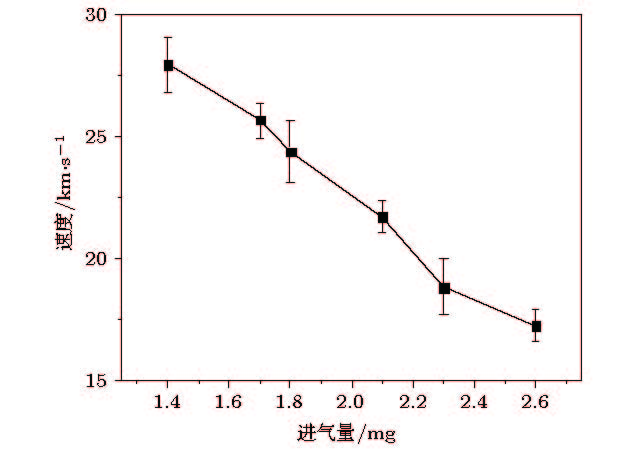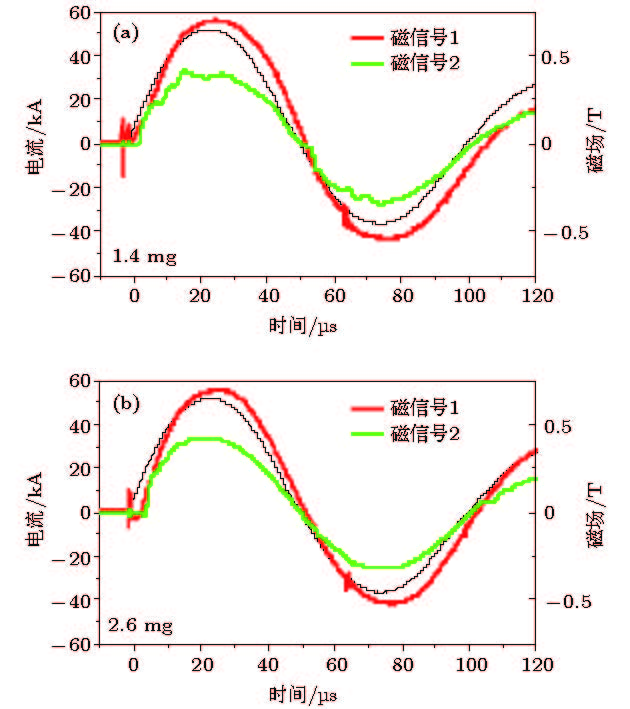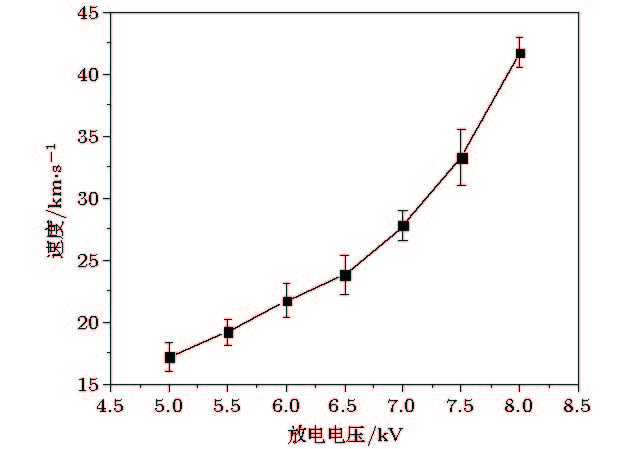-
同轴枪强流脉冲放电常见有爆燃模式和预填充模式两种放电模式, 爆燃模式放电可以得到杂质少、准直性高、输运速度更快的等离子体射流. 本实验主要对不同电压及进气量下同轴枪强流脉冲爆燃模式放电的等离子体特性进行了研究. 结果表明, 在相同放电电压下, 进气量少时会有多团等离子体从枪口喷出. 随着进气量的增加, 同轴枪放电产生的等离子体密度增加, 输运速度减小, 最终等离子体只有一团从枪口喷出; 而在相同进气量下, 随着电压的增加, 等离子体密度增加, 输运速度增大, 开始出现有多团等离子体从枪口喷出的现象. 产生该现象的原因主要是在放电过程中, 当气体持续进入枪底部时, 同轴枪底部会产生新的电流通道向前运动, 使得在同轴枪出口处观察到了多团等离子体喷出的现象; 随着放电电压的增加, 在放电过程中回路电流也增加. 当电流增加到一定程度时, 同轴枪底部就会产生新的电流通道, 从而有多个等离子体团从枪口喷出. 通过改变充电电容以及对磁探针信号的分析, 进一步分析并验证了同轴枪底端多次放电的现象.Coaxial gun can produce high-speed and high-density plasma jet and has some potential applications in many research areas such as space thruster, space debris impact simulation, nuclear fusion, and material processing. The coaxial gun is usually composed of a pair of coaxial cylindrical and hollow electrodes. The pulsed discharge of coaxial gun has two discharge modes, i.e., deflagration mode and pre-fill mode. Compared with the pre-fill mode, deflagration discharge mode can induce a plasma jet with few impurities, high collimation, and fast speed. In this paper, the effect of gas injection mass and discharge voltage on the discharge characteristic of deflagration mode are studied with electrical and optical diagnosis including the emission spectrum, plasma velocity and discharge current measurements. The experimental results show that when the gas injection mass is relatively low, such as 1.4 mg, many plasma clusters eject from the muzzle. As the gas flowing into the coaxial gun bottom increases, the plasma density increases and the jet velocity decreases. Eventually, when the gas injection mass increases to 2.6 mg, one cluster of plasma is found and ejects from the muzzle of the gun. In the discharge process, as a small quantity of gas flows into the bottom of the coaxial gun through the electromagnetic valve continuously, new current paths will be generated at the bottom of the coaxial gun and move forward. This results in the observation of multiple plasma jet at the exit of the coaxial gun. It is noted that the plasma densities are different for different gas mass flowing into coaxial gun bottom, but the currents have little effect in the first discharge half cycle due to the small plasma inductance in discharge circuit. Meanwhile, the plasma characteristics under different voltages with the fixed gas mass of 2.6 mg flowing into the coaxial gun bottom are experimentally measured. The results show that the plasma density and speed increase with voltage increasing, which is attributed to the stronger discharge current and larger self-induced Lorentz force. More neutral particles can be ionized into plasma with discharge voltage increasing, and the transport speed becomes faster under the enhanced force. In addition, the multiple ionization phenomena are observed again when the discharge voltage increases from 5 kV to 8 kV. This study provides an insight into how to better apply the coaxial gun discharge plasma to practical engineering field. The article further verifies the phenomenon of multiple discharges at the bottom of the coaxial gun by changing the charging capacitance and analyzing the magnetic probe signals.
-
Keywords:
- coaxial gun /
- deflagration mode /
- plasma /
- discharge parameters
[1] Marshall J 1960 Phys. Fluids 3 134
[2] 杨亮, 张俊龙, 闫慧杰, 滑跃, 任春生 2017 物理学报 66 055203
 Google Scholar
Google Scholar
Yang L, Zhang J L, Yan H J, Hua Y, Ren C S 2017 Acta Phys. Sin. 66 055203
 Google Scholar
Google Scholar
[3] 杨亮, 闫慧杰, 张俊龙, 滑跃, 任春生 2014 高电压技术 40 2113
Yang L, Yan H J, Zhang J L, Hua Y, Ren C S 2014 High Voltage Engineering 40 2113
[4] Witherspoon F D, Case A, Messer S J, B R, Phillips M W, Brockington S, Elton R 2009 Rev. Sci. Instrum. 80 363
[5] Bhuyan H, Mohanty S R, Neog N K, Bujarbarua S, Rout R K 2003 Meas. Sci. Technol. 14 1769
 Google Scholar
Google Scholar
[6] Mather J W 1965 Phys. Fluids 8 366
 Google Scholar
Google Scholar
[7] Mather J W 1963 Phys. Fluids 7 S28
[8] Cheng D Y 1971 AIAA J. 9 1681
 Google Scholar
Google Scholar
[9] 李宏伟, 韩建伟, 吴逢时, 蔡明辉, 张振龙 2014 物理学报 63 119601
 Google Scholar
Google Scholar
Li H W, Han J W, Wu F S, Cai M H, Zhang Z L 2014 Acta Phys. Sin. 63 119601
 Google Scholar
Google Scholar
[10] 李宏伟, 韩建伟, 蔡明辉, 吴逢时 2013 物理学报 62 229601
 Google Scholar
Google Scholar
Li H W, Han J W, Cai M H, Wu F S 2013 Acta Phys. Sin. 62 229601
 Google Scholar
Google Scholar
[11] 高著秀, 冯春华, 杨宣宗, 黄建国, 韩建伟 2012 物理学报 61 145201
 Google Scholar
Google Scholar
Gao Z X, Feng C H, Yang X Z, Huang J G, Han J W 2012 Acta Phys. Sin. 61 145201
 Google Scholar
Google Scholar
[12] Turchi P J, Roderick N F, Degnan J H, Frese M H, Amdahl D J 2008 IEEE Trans. Plasmas Sci. 36 92
 Google Scholar
Google Scholar
[13] Schoenberg K F, Gerwin R A, Moses Jr R W, Scheuer J T, Wagner H P 1998 Phys. Plasmas 5 2090
 Google Scholar
Google Scholar
[14] Woodall D M, Len L K 1985 J. Appl. Phys. 57 961
 Google Scholar
Google Scholar
[15] Poehlmann F R 2010 Ph. D Dissertation (Stamford: Stanford University)
[16] 刘帅, 黄易之, 郭海山, 张永鹏, 杨兰均 2018 物理学报 67 065201
 Google Scholar
Google Scholar
Liu S, Huang Y Z, Guo H S, Zhang Y P, Yang L J 2018 Acta Phys. Sin. 67 065201
 Google Scholar
Google Scholar
[17] Rabiński M, Zdunek K 2003 Vacuum 70 303
 Google Scholar
Google Scholar
[18] Liu S, Huang Y Z, Guo H S, Lin T Y, Huang D, Yang L J 2018 Phys. Plasmas 25 053506
 Google Scholar
Google Scholar
[19] Loebner K T K, Wang B C, Poehlmann F R, Watanabe Y, Cappelli M A 2014 IEEE Trans. Plasmas Sci. 42 2500
 Google Scholar
Google Scholar
[20] Poehlmann F R, Cappelli M A, Rieker G B 2010 Phys. Plasmas 17 333
[21] Rieker G B, Poehlmann F R, Cappelli M A 2013 Phys. Plasmas 20 07311
[22] Subramaniam V, Underwood T C, Raja L L, Cappelli M A 2018 Plasma. Sources Sci. T. 27 025016
 Google Scholar
Google Scholar
[23] Ashkenazy J, Kipper R, Caner M 1991 Physical Rev. A 43 568
 Google Scholar
Google Scholar
[24] Wiechula J, Hock C, Iberler M, Manegold T, Schonlein A, Jacoby J 2015 Phys. Plasmas 22 043516
 Google Scholar
Google Scholar
-
-
[1] Marshall J 1960 Phys. Fluids 3 134
[2] 杨亮, 张俊龙, 闫慧杰, 滑跃, 任春生 2017 物理学报 66 055203
 Google Scholar
Google Scholar
Yang L, Zhang J L, Yan H J, Hua Y, Ren C S 2017 Acta Phys. Sin. 66 055203
 Google Scholar
Google Scholar
[3] 杨亮, 闫慧杰, 张俊龙, 滑跃, 任春生 2014 高电压技术 40 2113
Yang L, Yan H J, Zhang J L, Hua Y, Ren C S 2014 High Voltage Engineering 40 2113
[4] Witherspoon F D, Case A, Messer S J, B R, Phillips M W, Brockington S, Elton R 2009 Rev. Sci. Instrum. 80 363
[5] Bhuyan H, Mohanty S R, Neog N K, Bujarbarua S, Rout R K 2003 Meas. Sci. Technol. 14 1769
 Google Scholar
Google Scholar
[6] Mather J W 1965 Phys. Fluids 8 366
 Google Scholar
Google Scholar
[7] Mather J W 1963 Phys. Fluids 7 S28
[8] Cheng D Y 1971 AIAA J. 9 1681
 Google Scholar
Google Scholar
[9] 李宏伟, 韩建伟, 吴逢时, 蔡明辉, 张振龙 2014 物理学报 63 119601
 Google Scholar
Google Scholar
Li H W, Han J W, Wu F S, Cai M H, Zhang Z L 2014 Acta Phys. Sin. 63 119601
 Google Scholar
Google Scholar
[10] 李宏伟, 韩建伟, 蔡明辉, 吴逢时 2013 物理学报 62 229601
 Google Scholar
Google Scholar
Li H W, Han J W, Cai M H, Wu F S 2013 Acta Phys. Sin. 62 229601
 Google Scholar
Google Scholar
[11] 高著秀, 冯春华, 杨宣宗, 黄建国, 韩建伟 2012 物理学报 61 145201
 Google Scholar
Google Scholar
Gao Z X, Feng C H, Yang X Z, Huang J G, Han J W 2012 Acta Phys. Sin. 61 145201
 Google Scholar
Google Scholar
[12] Turchi P J, Roderick N F, Degnan J H, Frese M H, Amdahl D J 2008 IEEE Trans. Plasmas Sci. 36 92
 Google Scholar
Google Scholar
[13] Schoenberg K F, Gerwin R A, Moses Jr R W, Scheuer J T, Wagner H P 1998 Phys. Plasmas 5 2090
 Google Scholar
Google Scholar
[14] Woodall D M, Len L K 1985 J. Appl. Phys. 57 961
 Google Scholar
Google Scholar
[15] Poehlmann F R 2010 Ph. D Dissertation (Stamford: Stanford University)
[16] 刘帅, 黄易之, 郭海山, 张永鹏, 杨兰均 2018 物理学报 67 065201
 Google Scholar
Google Scholar
Liu S, Huang Y Z, Guo H S, Zhang Y P, Yang L J 2018 Acta Phys. Sin. 67 065201
 Google Scholar
Google Scholar
[17] Rabiński M, Zdunek K 2003 Vacuum 70 303
 Google Scholar
Google Scholar
[18] Liu S, Huang Y Z, Guo H S, Lin T Y, Huang D, Yang L J 2018 Phys. Plasmas 25 053506
 Google Scholar
Google Scholar
[19] Loebner K T K, Wang B C, Poehlmann F R, Watanabe Y, Cappelli M A 2014 IEEE Trans. Plasmas Sci. 42 2500
 Google Scholar
Google Scholar
[20] Poehlmann F R, Cappelli M A, Rieker G B 2010 Phys. Plasmas 17 333
[21] Rieker G B, Poehlmann F R, Cappelli M A 2013 Phys. Plasmas 20 07311
[22] Subramaniam V, Underwood T C, Raja L L, Cappelli M A 2018 Plasma. Sources Sci. T. 27 025016
 Google Scholar
Google Scholar
[23] Ashkenazy J, Kipper R, Caner M 1991 Physical Rev. A 43 568
 Google Scholar
Google Scholar
[24] Wiechula J, Hock C, Iberler M, Manegold T, Schonlein A, Jacoby J 2015 Phys. Plasmas 22 043516
 Google Scholar
Google Scholar
计量
- 文章访问数: 11817
- PDF下载量: 85
- 被引次数: 0














 下载:
下载:













